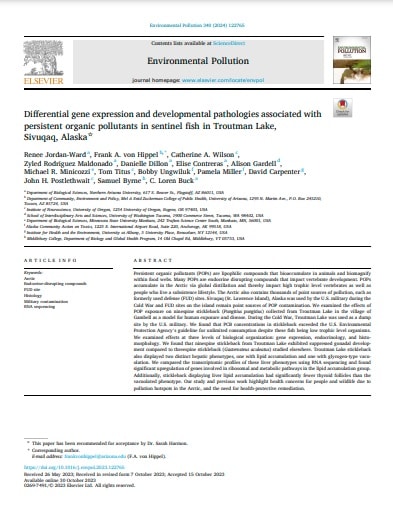Differential gene expression and developmental pathologies associated with persistent organic pollutants in sentinel fish in Troutman Lake, Sivuqaq, Alaska
About/Abstract
Persistent organic pollutants (POPs) are lipophilic compounds that bioaccumulate in animals and biomagnify within food webs. Many POPs are endocrine disrupting compounds that impact vertebrate development. POPs accumulate in the Arctic via global distillation and thereby impact high trophic level vertebrates as well as people who live a subsistence lifestyle. The Arctic also contains thousands of point sources of pollution, such as formerly used defense (FUD) sites. Sivuqaq (St. Lawrence Island), Alaska was used by the U.S. military during the Cold War and FUD sites on the island remain point sources of POP contamination. We examined the effects of POP exposure on ninespine stickleback (Pungitius pungitius) collected from Troutman Lake in the village of Gambell as a model for human exposure and disease. During the Cold War, Troutman Lake was used as a dump site by the U.S. military. We found that PCB concentrations in stickleback exceeded the U.S. Environmental Protection Agency’s guideline for unlimited consumption despite these fish being low trophic level organisms. We examined effects at three levels of biological organization: gene expression, endocrinology, and histomorphology. We found that ninespine stickleback from Troutman Lake exhibited suppressed gonadal development compared to threespine stickleback (Gasterosteus aculeatus) studied elsewhere. Troutman Lake stickleback also displayed two distinct hepatic phenotypes, one with lipid accumulation and one with glycogen-type vacuolation. We compared the transcriptomic profiles of these liver phenotypes using RNA sequencing and found significant upregulation of genes involved in ribosomal and metabolic pathways in the lipid accumulation group. Additionally, stickleback displaying liver lipid accumulation had significantly fewer thyroid follicles than the vacuolated phenotype. Our study and previous work highlight health concerns for people and wildlife due to pollution hotspots in the Arctic, and the need for health-protective remediation.
Keywords/Info
- Arctic
- Endocrine-disrupting compounds
- FUD site
- Histology
- Military contamination
- RNA sequencing

